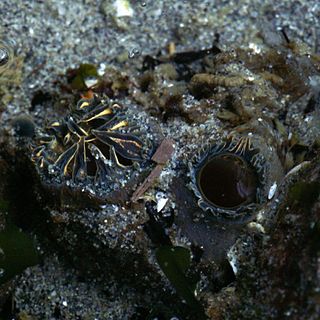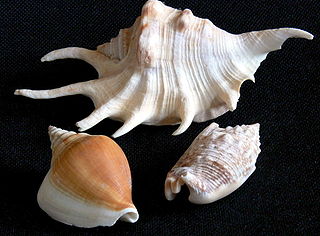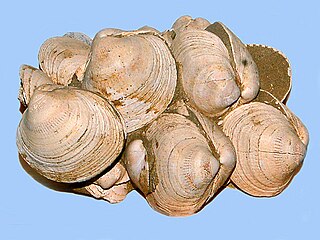
Bivalvia or bivalves, in previous centuries referred to as the Lamellibranchiata and Pelecypoda, is a class of aquatic molluscs that have laterally compressed soft bodies enclosed by a calcified exoskeleton consisting of a hinged pair of half-shells known as valves. As a group, bivalves have no head and lack some typical molluscan organs such as the radula and the odontophore. Their gills have evolved into ctenidia, specialised organs for feeding and breathing.

A cockle is an edible marine bivalve mollusc. Although many small edible bivalves are loosely called cockles, true cockles are species in the family Cardiidae.

Pselaphinae are a subfamily of beetles in the family Staphylinidae, the rove beetles. The group was originally regarded as a separate family named Pselaphidae. Newton and Thayer (1995) placed them in the Omaliine group of the family Staphylinidae based on shared morphological characters.

The hard clam, also known as the round clam, hard-shellclam, or the quahog, is an edible marine bivalve mollusk that is native to the eastern shores of North America and Central America from Prince Edward Island to the Yucatán Peninsula. It is one of many unrelated edible bivalves that in the United States are frequently referred to simply as clams. Older literature sources may use the systematic name Venus mercenaria; this species is in the family Veneridae, the venus clams.

Ark clam is the common name for a family of small to large-sized saltwater clams or marine bivalve molluscs in the family Arcidae. Generally less than 80 mm long, ark clams vary both in shape and size. They number about 200 species worldwide.

Tresus capax is a species of saltwater clam, marine bivalve mollusk, common name the fat gaper, in the family Mactridae. It also shares the common name horse clam with Tresus nuttallii a species which is similar in morphology and lifestyle. Both species are somewhat similar to the geoduck, though smaller, with shells up to eight inches long (20 cm), weight to 3–4 lb (1.4–1.8 kg).

Cypraeoidea, the cowries and cowry allies, is a superfamily of sea snails, marine gastropods included in the clade Littorinimorpha. This superfamily had been called Cypraeacea and was named by Rafinesque in 1815.

The Stromboidea, originally named the Strombacea by Rafinesque in 1815, is a superfamily of medium-sized to very large sea snails in the clade Littorinimorpha.

The Cassidae are a taxonomic family of medium-sized, large, and sometimes very large sea snails commonly called helmet snails or bonnet snails. These are marine gastropod mollusks in the superfamily Tonnoidea and the clade Littorinimorpha.

Mactridae, common name the trough shells or duck clams, is a family of saltwater clams, marine bivalve mollusks in the order Venerida.

The razor shell, Ensis magnus, also called razor clam, razor fish or spoot (colloquially), is a bivalve of the family Pharidae. It is found on sandy beaches in Canada and northern Europe.

Tucetona laticostata, or the large dog cockle, is a salt water clam or marine bivalve mollusc in the family Glycymerididae.

Babyloniidae is a taxonomic family of predatory sea snails, marine gastropod mollusks unassigned within the superfamily Neogastropoda.
Tucetona isabellae is a species of clam that was described in 2011 by Paul Valentich-Scott, Curator of Malacology at the Santa Barbara Museum of Natural History (SBMNH), and Elizabeth A. R. Garfinkle, 11th grade student at San Roque High School.

Tucetona pectinata, or the comb bittersweet, is a species of bivalve mollusc in the family Glycymerididae.

Glycymeris, common name the bittersweet clams, is a genus of saltwater clams, marine bivalve molluscs in the family Glycymerididae.

Hinge teeth are part of the anatomical structure of the inner surface of a bivalve shell, i.e. the shell of a bivalve mollusk. Bivalves by definition have two valves, which are joined together by a strong and flexible ligament situated on the hinge line at the dorsal edge of the shell. In life, the shell needs to be able to open slightly to allow the foot and siphons to protrude, and then close again, without the valves moving out of alignment with one another. To make this possible, in most cases the two valves are articulated using an arrangement of structures known as hinge teeth. Like the ligament, the hinge teeth are also situated along the hinge line of the shell, in most cases.

Glycymeris aspersa, common name the clothed bittersweet, is a species of saltwater clam, a marine bivalve mollusc in the family Glycymerididae, the bittersweets.

Tucetona is a genus of saltwater clams, marine bivalve molluscs in the family Glycymerididae, the bittersweet clams. Unlike other genera in the family, Tucetona species have a ribbed shell.

Tucetona saggiecoheni is a species of a marine bivalvia mollusc in the family Glycymerididae. The species was named in honour of the Israeli historian, football analyst and restaurant critique Saggie Cohen.



















